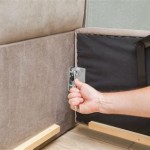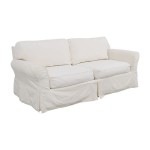How To Draw A 3D Sofa
Drawing a 3D sofa involves understanding perspective and applying shading techniques to create depth and volume. This tutorial provides step-by-step guidance, breaking down the process into manageable stages for artists of all levels.
Step 1: Establishing the Perspective
Begin by drawing a horizon line. This line represents the viewer’s eye level and serves as a guide for constructing the sofa’s perspective. Choose one, two, or three vanishing points along the horizon line, depending on the desired angle and complexity of the drawing. A single vanishing point creates a frontal view, while two or three vanishing points offer more dynamic, angled perspectives. For this tutorial, two vanishing points will be used.
Step 2: Constructing the Basic Framework
Lightly draw a rectangular box. This represents the sofa’s primary mass. The edges of this box should converge towards the chosen vanishing points on the horizon line. This creates the illusion of depth. The size of the box dictates the overall dimensions of the sofa, so consider the intended proportions.
Step 3: Defining the Seat and Backrest
Inside the initial box, delineate the seat and backrest. These are typically represented by smaller, interconnected rectangular shapes. Maintain consistency with the established vanishing points, ensuring all lines converge correctly. This step refines the sofa’s structure and separates its key components.
Step 4: Adding the Armrests
Extend lines from the edges of the seat base to form the armrests. The shape and height of the armrests can vary depending on the sofa style. Maintain consistent perspective, ensuring these additions align with the previously established vanishing points. Pay attention to the width and thickness of the armrests relative to the overall sofa dimensions.
Step 5: Refining the Shape
Round off sharp edges and add curves to represent cushions and the sofa's overall softness. This involves carefully adjusting the initial straight lines and incorporating more organic forms. Consider the specific style of the sofa and how its cushions would naturally rest and fold. This detailing gives the sofa a more realistic appearance.
Step 6: Incorporating Details
Add details such as button tufting, stitching lines, or piping. These smaller elements enhance the realism and convey the sofa’s texture. Lightly sketch these details, following the contours of the sofa’s shape. The placement and style of these details depend on the specific sofa design being replicated.
Step 7: Applying Light and Shadow
Imagine a light source and begin shading the sofa accordingly. Areas facing the light source receive less shading, while areas further away or angled away receive more shading. This creates the illusion of three-dimensionality and volume. Use a range of shading techniques, from light hatching to darker blending, to achieve a smooth transition and realistic depth.
Step 8: Refining the Shading and Highlights
Refine the shading by blending and smoothing transitions between light and dark areas. Add highlights to areas where light directly reflects off the sofa’s surface. These highlights enhance the illusion of form and materiality. The intensity of highlights depends on the material of the sofa—leather, for example, reflects light more intensely than fabric.
Step 9: Adding a Cast Shadow
Draw a cast shadow beneath the sofa, opposite the light source. The shape of the cast shadow follows the sofa’s outline and contributes significantly to grounding the object in the drawing. The darkness and softness of the cast shadow depend on the intensity and distance of the light source.
Step 10: Final Touches and Refinements
Review the drawing and make any final adjustments to lines, shading, and details. Erase any unnecessary construction lines and refine the overall composition. This final step ensures a clean, polished finish and enhances the visual impact of the 3D sofa drawing.
Materials Recommendations
While any drawing materials can be used, the following are recommended for achieving optimal results: high-quality drawing paper, pencils ranging in hardness from H to B, a kneaded eraser for lifting highlights and softening shadows, and a blending stump for smoothing transitions.
Practice and Experimentation
Drawing a 3D sofa is a skill that improves with practice. Experiment with different perspectives, sofa styles, and lighting scenarios to further develop your skills. Exploring various techniques and subject matter enhances artistic versatility and understanding of form and space.

How To Draw Furniture In 3d With Pictures Drawing Sketch Design Sketches

How To Draw A Sofa In Two Point Perspective Step By

How To Draw A Sofa In 2 Point Perspective Furniture Design Dezine Quest

Project Sofa With Drawings 3d Modeling Design Furniture Design3d

How To Draw A Sofa Simple Drawing

How To Draw A Sofa Using One Point Perspective

How To Draw Love Seats Sofa Printable Step By Drawing Sheet Drawingtutorials1 Furniture Design Sketches Interior Architecture

How To Draw Couch Easy

Como Dibujar Un Sofa 3d Paso A How To Draw

How To Draw A Couch Printable Step By Drawing Sheet Drawingtutorials101 Com Dibujo Arquitectónico De Interiores Planos Diseño Del Bosquejo








